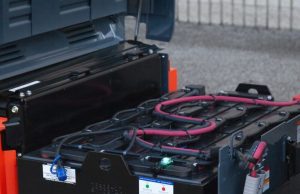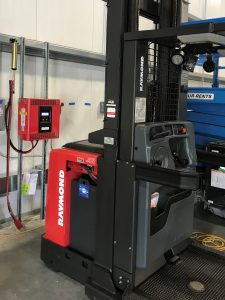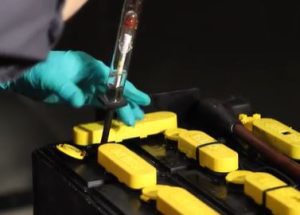When it comes to forklift expenses, batteries are at the top of the list. It is imperative that operators properly charge and water their batteries to ensure they maximize their lifespan and maintain a steady and consistent workflow within the warehouse. For industrial forklift batteries there is a lot you need to know about proper charging and watering procedures for maximum warehouse efficiency.
charge and water their batteries to ensure they maximize their lifespan and maintain a steady and consistent workflow within the warehouse. For industrial forklift batteries there is a lot you need to know about proper charging and watering procedures for maximum warehouse efficiency.
The Importance of Properly Charging Batteries
Think of filling your gas tank before a long trip; you want to make sure the battery has a complete state of charge for six to eight hours of run time in a single operating shift. Properly charging your batteries leads to less downtime, no loss of productivity, and a reduction of shipment delays due to downtime from the forklift batteries not being up to the full state of charge.
Battery Lifespan
Batteries are a huge investment, especially in the current economic climate. A typical industrial forklift battery has a lifespan of a five-years or more and includes a five-year warranty. If you do not take the proper housekeeping steps, such as charging and watering at the correct intervals, you will negate the warranty and possibly damage the battery cells. Eventually, it will decrease the battery’s output, effect equipment run time, and lose life expectancy.
Forklift Implications from Improper Battery Charging
 It’s not just the battery itself that can go bad. Forklifts need a certain amount of power to perform its functions. When a battery is not adequately charged, it puts out lower voltage. Power is defined as voltage X current (measured in amps). To make up for low voltage the trucks will draw higher amps, resulting in heat buildup and a deleterious effect on the electrical components and electronics.
It’s not just the battery itself that can go bad. Forklifts need a certain amount of power to perform its functions. When a battery is not adequately charged, it puts out lower voltage. Power is defined as voltage X current (measured in amps). To make up for low voltage the trucks will draw higher amps, resulting in heat buildup and a deleterious effect on the electrical components and electronics.
The Steps to Properly Charging Batteries
Only charge a battery when the battery gauge on the lift shows about 25% power remaining and remember to charge the battery first and fill with water after. Attempting to charge the battery when it is down to 0% may result in the battery not charging as the charger may not register there is a battery that is in need of charging.
Let it drop down to 25% for daily use, plug it in, and the charger will automatically charge to 100% and then disconnect when complete. If charging over the weekend, plug it in at 25% on Friday. Get in the habit of utilizing the equalize button on the charger. It takes a longer time to charge by sending low current out to all cells but is needed to periodically refresh the cells.
Do not plug in the battery multiple times a day unless it is a designated opportunity charger system. Plugging in multiple times a day will decrease the battery life. The battery is designed for only a single charge and discharge cycle per charging event.
The Battery Watering Process and Importance
Always charge the battery before filling the battery with water (i.e., charge on Friday, fill water on Monday). This is crucial because batteries have acid in them and need water as a conduit for the acid to work correctly. If you run out of water in a cell and it’s dry, the acid doesn’t have any place to work. You would be frying the cell, rendering it useless and in need of replacement. Remove the cap’s cover and look inside. If water is over the top of the plate that looks like a honeycomb, that is good. If there isn’t any water over the plate, add enough to cover the top of the plate.
This is crucial because batteries have acid in them and need water as a conduit for the acid to work correctly. If you run out of water in a cell and it’s dry, the acid doesn’t have any place to work. You would be frying the cell, rendering it useless and in need of replacement. Remove the cap’s cover and look inside. If water is over the top of the plate that looks like a honeycomb, that is good. If there isn’t any water over the plate, add enough to cover the top of the plate.
Another type of battery watering is a single-point watering system. A series of tubes interconnect on top of the battery and go to a single small hose valve that interfaces with the direct fill line. Run the hose to the water source, plug it in, and it fills each cell in three seconds without needing to pull the caps off. This saves time as the team does not have to put on protective gear. It also increases efficiency, especially for those who are not good at battery and warehouse housekeeping procedures.
Keep Your Head Above Water with Proper Battery Charging and Watering
At Abel Womack, our team works closely with our battery partners to ensure our customers are educated on battery charging and watering best practices. We can run a quick tutorial for customers on correct battery watering techniques, schedules, and warehouse signage to encourage proper procedures. Please contact our specialists today for more information on batteries, proper charging and watering, or energy products and solutions.



Leave a Reply
You must be logged in to post a comment.